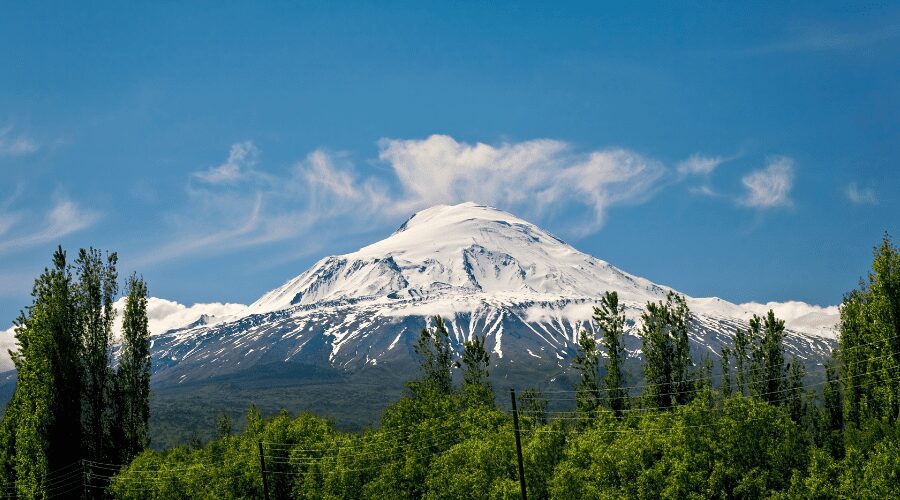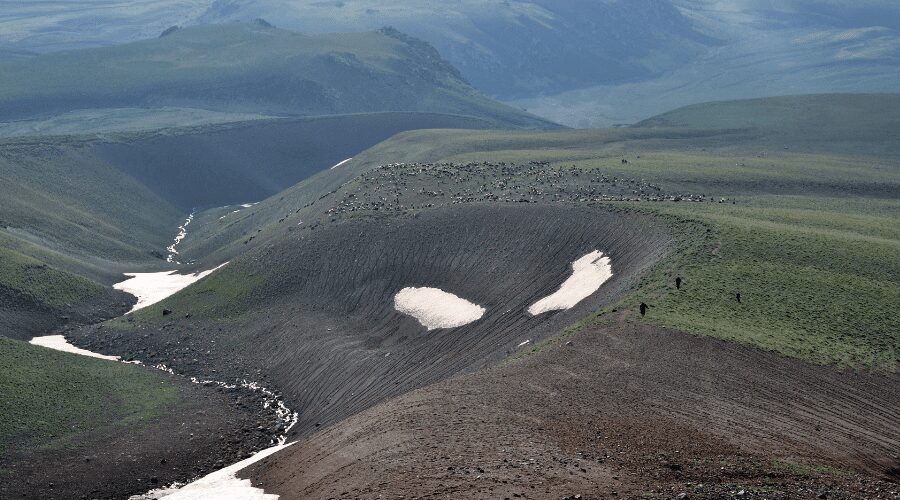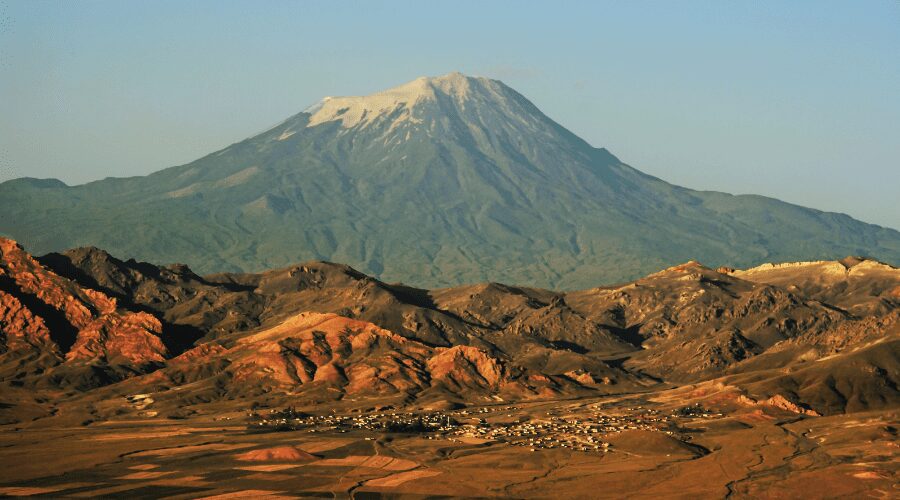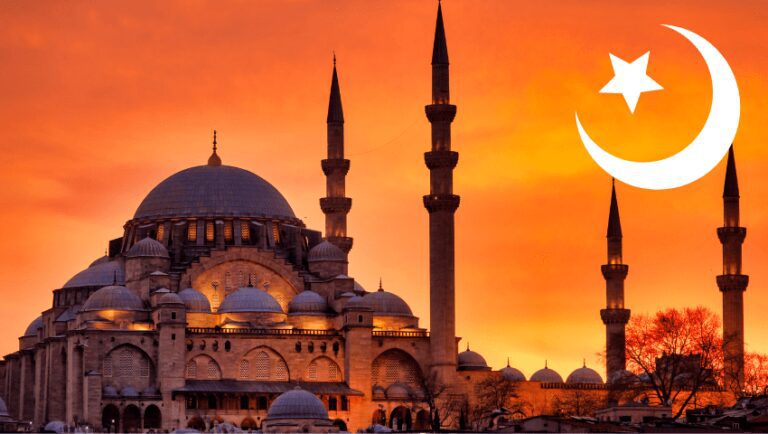Table of Contents
Mount Ararat has captivated the imagination of explorers, theologians, and historians for centuries. Its towering presence and connection to the biblical story of Noah’s Ark make it an intriguing destination for both adventurers and the faithful.
In this article, we’ll explore the geography, mythology, and significance of this majestic peak.

Mount Ararat: Location, Elevation, and Facts
Geographical Location in Turkey
Mount Ararat is located in eastern Turkey, near the borders of Iran and Armenia. It is the highest peak in the country and the centerpiece of the Ararat massif, which consists of two volcanic cones: Greater Ararat and Lesser Ararat.
Mount Ararat is called Mount Agri in Turkey.
Elevation and Prominence
- Greater Ararat: With an elevation of 16,854 feet (5,137 meters), it is the tallest peak in Turkey and the Armenian Highland.
- Lesser Ararat: Rising to 12,782 feet (3,896 meters), it is the second-highest peak in the massif.
Formation and Geological Features
Mount Ararat is a dormant stratovolcano, formed through the accumulation of lava flows, ash, and other volcanic materials. The last known eruption occurred around 2,500 BCE.
Climate and Wildlife
The mountain’s climate varies with elevation, ranging from mild temperatures in the foothills to snow and ice at higher altitudes. The diverse landscape supports a rich variety of flora and fauna, including:
- Wildflowers and alpine plants
- Mammals like bears, wolves, and lynxes
- Over 100 species of birds
Noah’s Ark Found in Turkey
Biblical Story of Noah’s Ark
In the biblical story, God instructed Noah to build an ark to save his family and two of every animal species from a global flood. After the floodwaters receded, the Ark came to rest on a mountain.
The Biblical Story of Noah’s Ark
The story of Noah’s Ark is found in the book of Genesis, chapters 6-9. In this narrative, God becomes disheartened by the wickedness of humanity and decides to cleanse the Earth with a great flood. However, God chooses Noah, a righteous man, to build an ark to save his family and a pair of every animal species on Earth.
The Bible provides specific instructions for the construction of the Ark, as seen in :
“So make yourself an ark of cypress wood; make rooms in it and coat it with pitch inside and out. This is how you are to build it: The ark is to be three hundred cubits long, fifty cubits wide and thirty cubits high. Make a roof for it, leaving below the roof an opening one cubit high all around; put a door in the side of the ark and make lower, middle and upper decks.”
Genesis 6:14-16 (New International Version)
Noah obeys God’s command and builds the Ark. The floodwaters cover the Earth, destroying all life, except for those aboard the Ark. Eventually, the waters recede, and the Ark comes to rest on “the mountains of Ararat” (Genesis 8:4).

Quotes from Popes and Other Christian Leaders
While there aren’t many direct quotes from popes or prominent Christian leaders about the Ark, some have referred to the story as an allegory or symbol for various spiritual teachings.
Pope Francis has used the story of Noah’s Ark as a symbol of God’s mercy, emphasizing the importance of accepting God’s forgiveness and compassion. In a 2016 homily, he stated:
“The Lord has always remembered his covenant. The Lord never forgets. Yes, he forgets only in one case when he forgives sins. After he has forgiven he loses his memory, he does not remember the sins. In other cases, God does not forget.”
Saint Augustine of Hippo (354-430), an influential Christian theologian, offered an allegorical interpretation of the story in his work, “City of God.” He saw the Ark as a symbol of the Church and salvation, with the flood representing the trials and tribulations of life.
John Chrysostom (349-407), another early Christian leader, wrote a series of homilies on Genesis. In these homilies, he delved into the moral lessons to be learned from the story of Noah’s Ark, such as obedience to God, the importance of faith, and the consequences of sin.
While the story of Noah’s Ark has been interpreted and discussed by various Christian leaders throughout history, its core message of faith, obedience, and God’s mercy remains central to its significance.
Mount Ararat as the Alleged Resting Place of the Ark
The Book of Genesis identifies “the mountains of Ararat” as the final resting place of Noah’s Ark. Many believe this refers to the summit of Mount Ararat in Turkey.
Historical Searches for the Ark
Over the centuries, numerous expeditions have attempted to locate the Ark on Mount Ararat. While some have claimed to find evidence, no definitive proof has emerged.
Controversial Findings and Ongoing Debate
Claims of discovering Noah’s Ark on Mount Ararat have been met with skepticism from experts. The lack of conclusive evidence has led to ongoing debate about the Ark’s existence and location.
Significance of Mount Ararat
Religious Importance
- Significance for Christianity: Mount Ararat holds special meaning for many Christians due to its association with Noah’s Ark.
- Connection to Judaism and Islam: The Ark story is also shared by Judaism and Islam, making Mount Ararat significant to followers of these faiths as well.
Impact on Local Communities and Economy
Mount Ararat attracts tourists and pilgrims from around the world, contributing to the local economy. The mountain also serves as a source of water for nearby communities.
Ecotourism and Conservation Efforts
With its unique biodiversity and cultural importance, Mount Ararat has become a focus of ecotourism and conservation initiatives. Efforts to protect the mountain’s ecosystems and promote sustainable tourism help ensure its future.
Visiting Mount Ararat
Obtaining Permits and Working with Local Guides
Due to its location near sensitive borders and its military significance, climbing Mount Ararat requires a special permit from the Turkish government. It’s essential to work with a licensed tour operator who can arrange the necessary permits and provide experienced local guides for your climb.
Best Time to Visit and Recommended Routes
- Best time to visit: The ideal climbing season is from June to September when the weather is most favorable.
- Recommended routes: The most popular route to the summit is the southern approach, starting from the village of Doğubayazıt.
Preparing for the Climb: Tips and Advice
- Physical fitness: Ensure you are in good physical condition and have prior experience with high-altitude trekking.
- Acclimatization: Allow time for acclimatization to minimize the risk of altitude sickness.
- Equipment: Bring appropriate gear, including warm clothing, sturdy boots, and climbing equipment.
- Safety: Be prepared for rapidly changing weather conditions and follow the guidance of your local guides.

Respecting the Environment and Cultural Significance
When visiting Mount Ararat, it’s crucial to show respect for both the environment and the cultural significance of the mountain. Keep these principles in mind:
- Leave no trace: Carry out all waste and minimize your impact on the fragile ecosystems.
- Cultural sensitivity: Be aware of the mountain’s significance to various faiths and communities, and show respect for their beliefs and customs.
- Support local businesses: Choose local tour operators and accommodations to contribute to the community’s economic well-being.
Conclusion
Mount Ararat’s importance and mystery have captivated people for generations. As you explore this majestic peak, remember to approach it with respect, curiosity, and an open mind. By doing so, you’ll contribute to the preservation of this unique treasure and the diverse communities that call it home.

